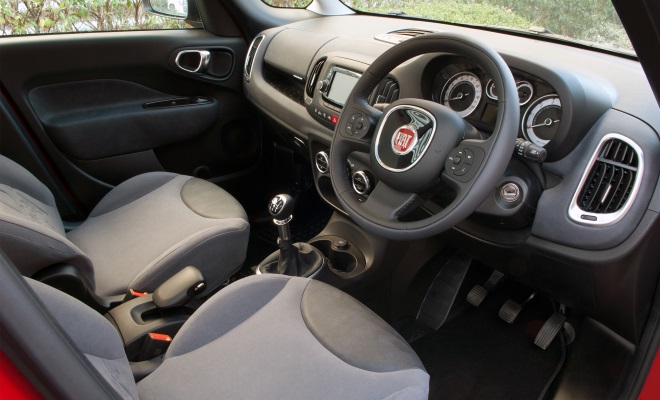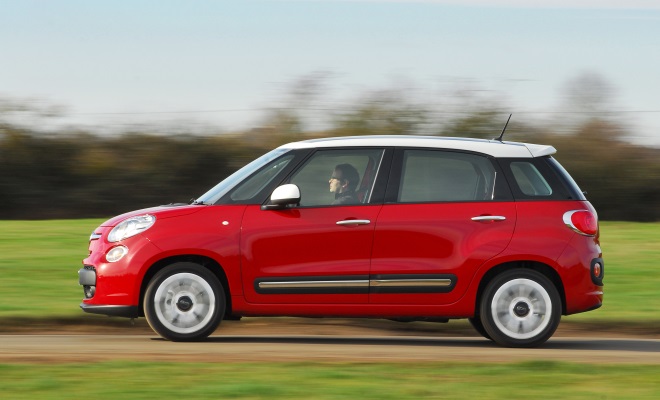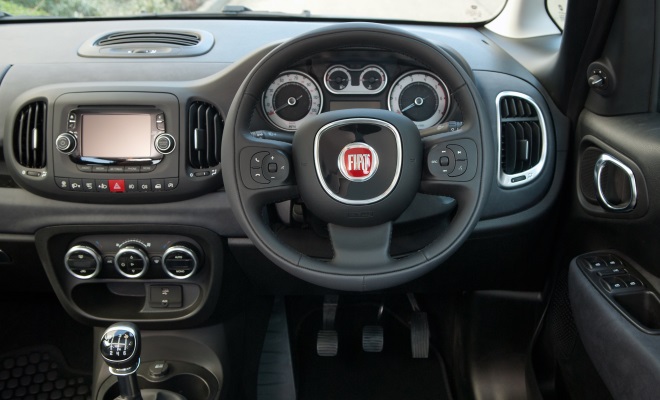
Rating: 3 out of 5 stars
Good: Well equipped, spacious, lots of options
Bad: Stodgy steering, lacklustre interior
Price: From £14,990
The retro-styled Fiat 500 has been a huge success since its introduction in 2007. Last year saw the little car’s biggest sales volume in the UK, defying the gravity that would normally tug figures firmly downward for a five-year-old car. Good: Well equipped, spacious, lots of options
Bad: Stodgy steering, lacklustre interior
Price: From £14,990
Fiat now hopes to spread some of that enduring lustre to other cars, by hatching new kinds of Fiat 500, establishing a sub-brand in the style of BMW’s Mini or Citroen’s DS.
The first fruit of this plan is a compact people-carrier called the Fiat 500L, due in showrooms very shortly. The L simply stands for “large”. A 500L Trekking edition will arrive later in the year, boasting a raised ride height, chunky exterior trim and an electronic limited-slip-differential to assist the resolutely front-wheel-drive car on slippery surfaces. An extended seven-seat version of the 500L will follow in the autumn, and there is even talk of a 500X softroader with full four-wheel-drive.
One wonders if Fiat hatched this masterplan quite late in the 500L’s development, because the new car seems a lot less like an inflated 500 than it does a grown-up Fiat Panda.

The latest Panda features a noticeable design motif dubbed a “squircle” – a square shape with rounded corners. And you can spot squircles all over the 500L – in the wheelarches, bumpers, rear lamp clusters and foglamps, lurking in the shapes of interior trim and even in the seams of the steering wheel. Distinctive resemblances to the retro Fiat 500 are noticeably harder to spot both inside and out – the car’s faces are similar, and there’s the ability to personalise both cars from a broad roster of options. But that’s about it.
So I’m not really convinced by the “500 goes large” marketing, but the 500L needs to be judged on its own merits in any case.
In photographs the 500L can resemble the Mini Countryman, but it’s quite different up close. It’s a crisper and less cartoonish design that’s also taller and more obviously a people-carrier, sharing more with the Citroen C3 Picasso than the big Mini.

Inside, there’s a surprising amount of space, particularly in the rear. There are fold-down tray tables in the back, lots of places to stow oddments, and a general feeling of family-friendly practicality. There are no clever doors to compete with the Ford B-Max or Vauxhall Meriva, but there is ample access for installing kids and thankfully the shorter ones won’t be able to kick the backs of the front seats. The split rear bench slides to trade space for legs or luggage, and can tumble forward to create a van-like cargo area. Seats up, the boot holds about 400 litres.
Up front, the two chairs are firmly upholstered and comfortable but almost as upright as a piano stool. They lack a little under-thigh support but they do provide a commanding view ahead – indeed vision in all directions is excellent, with the split windscreen pillars helping at junctions and the glazed rear pillars keeping things visible over the shoulder. Even without the optional panoramic sunroof, the 500L’s interior feels bright and airy.

On the move, the ride quality is generally good on the standard 16-inch wheels – on the firm side rather than pillowy and quite resistant to roll. However, some surfaces can outfox the crude rear suspension, allowing the tall body to start wagging like an excited dog.
My test car was fitted with the most expensive engine option – a 1.6-litre MultiJet turbodiesel providing 105bhp and 320Nm, and yielding combined-cycle scores of 62.8mpg and 117g/km. A lesser diesel and a petrol four-pot are also available, but the next best choice is probably the quirky two-cylinder TwinAir – a fizzing 0.9-litre petrol engine option that promises 105bhp, 112g/km and 58.9mpg.

The big diesel is the quickest off the mark, hitting 62mph in 11.3 seconds, but I doubt anyone would choose the 500L for its performance. The electrically assisted steering doesn’t lend itself to speed, feeling as if messages might be reaching the front wheels via Skype. Haul the wheel and there’s a feeling of rubbery resistance followed by a slightly out-of-synch course adjustment. As a result, I couldn’t help but back off before tackling even fairly modest bends on country roads.
In urban pottering and on dual carriageways the steering feels good enough, and as with other Fiats there’s a handy button to unlock extra assistance for parking. But a lack of steering fidelity at speed is the car’s biggest flaw, in my opinion.

The six-speed manual gearbox shifts cleanly, once you get used to the rather bulky knob. The handbrake is also manual, operated by an unusual lever the size and shape of a big bar of soap.
The engine automatically shuts down to save fuel whenever neutral is selected at a standstill. The resulting silence unfortunately reveals that zero volume on the radio doesn’t quite equal noises off – barely audible rustling sounds still emerge from the speakers as if the car might be haunted. Real silence requires switching the radio off, which also shuts down the central screen, so I chose eerie whispers instead.
Noise and vibration have been dealt with very well – at 70mph in sixth, the engine droning at 2,000rpm is the loudest sound, with both wind and tyre roar positively muffled. As a result, the cabin feels reasonably refined and relaxing over distance.
There are some nice touches to justify suggestions that the 500L might be a cut above workaday Fiats – a leather-trimmed helm with remote stereo controls is standard, for example, as is cruise control, basic aircon, and a five-inch touch-screen centre console. However, in the base-model “Pop Star” trim the materials seemed more tough and durable than tactile and desirable. That said, the top-spec Lounge edition does feature a suede-trimmed dashboard to lift the ambience, and nothing whatsoever squeaked or rattled during 100 miles of testing. Quality control at Fiat’s Serbian factory is clearly top notch.
Safety levels are also good – this is a five-star car according to EuroNCAP – with Fiat’s City Brake Control fitted as standard. This uses laser scanning to detect obstacles and can intervene to prevent or reduce the severity of collisions at closing speeds between 3mph and 19mph. I’ll have to take Fiat’s word for this, as I didn’t try it out myself.

I did make use of the Eco:Drive facility, which provides feedback on driving style in four categories: acceleration, braking, gear selection and use of speed. Ongoing feedback is offered via red, amber or green grades for the past few minutes of driving, or star-ratings in each category can be assessed at the end of each journey. Particularly keen green drivers can capture this data on a USB stick and analyse it on their home computer.
Achieving green lights across the board isn’t easy, requiring plenty of observation and forethought to avoid an amber or red warning for braking, for example. It also helps to follow the mostly sensible gearshift hints that appear on the instrument screen. My best efforts produced consumption of around 52mpg, while the trip computer showed a score of 48mpg for the previous 3,500 miles at the hands of unknown motoring writers, most of whom probably had two lead feet.
The final piece of the 500L puzzle is price. The range runs from £14,990 for the 1.4-litre petrol in “youthful” Pop Star spec or more slippers-and-pipe Easy trim, all the way up to £18,890 for the 1.6-litre diesel in luxurious Lounge spec. Choose a few options – metallic paint with a contrasting roof is £800, a DAB radio with Bluetooth costs £100, and a ten-speaker audio upgrade is £600 – and a well-appointed 500L might easily stray beyond £20,000.
That feels like quite a lot for a Fiat 500 – even a large one. But at more modest prices, in Pop Star trim, I suspect that Fiat will succeed in painting its new people carrier as a natural step up from its best-selling city car.




